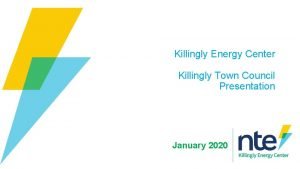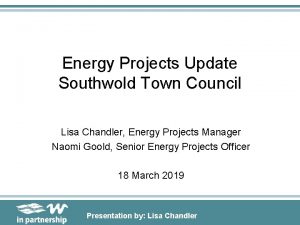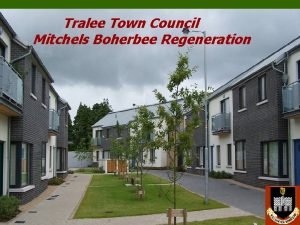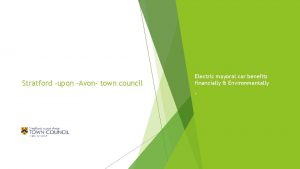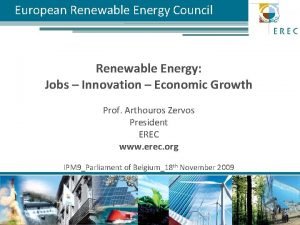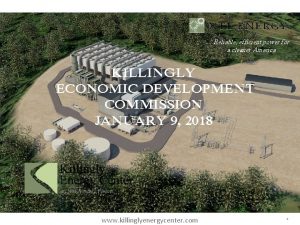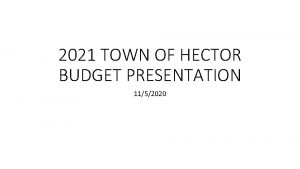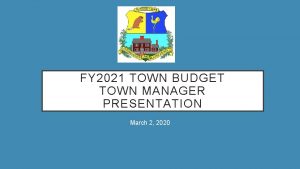Killingly Energy Center Killingly Town Council Presentation January

























- Slides: 25

Killingly Energy Center Killingly Town Council Presentation January 2020

Outline NTE Energy – Company Overview KEC Overview Agreements Infrastructure Improvements GHG Reduction Commitments Environmental Commitments Empowering Renewables Key Documents KEC Schedule Common Misconceptions 2

NTE Energy – Company Overview Footprint NTE is: Killingly Energy Center • a privately held company founded in 2009 Middletown Energy Center Boston • a leading power generation developer Kings Mountain Energy Center Reidsville Energy Center Gastonia Energy Center Charlotte • an energy solutions provider to structured markets, municipal and co-operative wholesale energy customers, providing some of the most reliable and efficient power resources in America • a full-service enterprise, providing construction and asset management services to its current and future projects Anderson County Energy Center St. Augustine (HQ) Homestead Generating Station • headquartered in St. Augustine, Florida, with offices in Boston and Charlotte Projects Under Construction Projects Under Development In Operation • More than $1. 1 billion in assets currently in operation, with $3 billion more in various stages of development NTE Offices 3

KEC Overview Background • NTE began development efforts of the Killingly Energy Center in 2015 • The site was selected due to its proximity to: 1. Electric and natural gas interconnection 2. The Killingly Industrial Park • The site was shown in the Town of Killingly’ s 2010 -2020 Plan of Conservation and Development as being included in an expanded Killingly Industrial Park (see map next page); 3. Available water. • Over the past 3 1/2 years, we have worked with the Town Council, Town Manager, Economic Development Director, Town staff and Town Commissions through all phases of development. • During the Connecticut Siting Council review process in 2016 -17, NTE worked with the Killingly Planning & Zoning and Inland Wetlands & Watercourses Commissions to assist in the preparation of their Regulate and Restrict Orders to the CSC • NTE funded a 3 rd party consultant, chosen by the town, to help the Commissions prepare their orders. • All the NTE presentations, permit applications and issued permits, technical information and a lot of other information was made available and kept up-to-date with copies located in the Town Hall, Town Library and on the Killingly Energy Center website (www. killinglyenergycenter. com) • NTE maintains a list of Frequently Asked Questions on the project website (see the example from Air section following).

KEC Overview Town of Killingly 2010 -2020 Plan of Conservation and Development - Map SITE

KEC Overview - Location I-395 Lake Rd. Gen Station Killingly Industrial Park Killingly Energy Center – Site Killingly Energy Center – Switchyard Frito-Lay Walgreens Dist. Center 6

KEC Overview – FAQ Example – Air Will KEC protect local air quality standards? KEC will be among the cleanest, most efficient natural gas power generation facilities in North America, utilizing state-of-the-art electric generation technology that will allow it to operate 25% more efficiently than the average electric generator in Connecticut. This means KEC will displace the operation of older, higher-emitting oil fired plants that would otherwise be needed to meet regional energy demand, helping improve overall air quality in Connecticut and New England. KEC’s air quality analysis was completed following Connecticut Department of Energy and Environmental Protection (DEEP) and United States Environmental Protection Agency (EPA) guidelines. The analysis is based on worst case scenario assumptions. Put another way, the analysis intentionally overstates the project’s potential impacts to ensure protection of air quality. Even with these worst-case assumptions, KEC’s modeled impacts are well within all applicable ambient air quality standards that have been established to protect even the most sensitive individuals. KEC will use a continuous air emissions monitoring system which measures and records emission levels to confirm and demonstrate our ongoing compliance with all federal and state emission standards and programs. This data is reported regularly to the DEEP and is available to the public. In addition, according to Richard Pirelli, the director of planning and standards at the CT Bureau of Air Management (within DEEP), over 90% of Connecticut’s air pollution comes from out-of-state, from upwind coal- and oil-burning power plants in the Midwest and South, as well as from mobile emissions (cars and trucks). By contrast, KEC will contribute to emissions decreases by displacing 1. 5 million tons of CO 2 (equivalent to planting over 35 million trees or taking over 50, 000 cars off the road for five years), 3, 500 tons of NOx and 1, 900 tons of SO 2 during the first five years of operation alone. Will the proximity of other power plants in this region negatively impact air quality in Killingly? We know there are concerns regarding the proximity of existing and potential power plants to Killingly. It’s easy to imagine that these plants are collectively contributing to a decline in Killingly’s air quality but, in fact, the exact opposite is true. Years of air quality data clearly demonstrate that the introduction of these new, more efficient natural gas plants into the generation mix, replacing older coal and oil fired units, has contributed to continuous improvements in air quality in Killingly and the broader region. Within a 100 -mile radius of Killingly, over 4500 MW (seven power plants) of coal and oil generation have retired or are at risk of retirement, thanks to cleaner, more efficient power generation sources in the region. As each new gas-fired combined cycle plant begins operation, older oil and coal plants with higher emission levels will run less frequently or retire, creating incremental improvements in Killingly’s air quality. What’s more, Killingly is not unique in the number and proximity of power plants in its immediate vicinity. When considering a similar radius around other communities throughout southern New England, many host similar counts of power generation units.

KEC Overview – FAQ Example - Air What is the “significant impact area” and what does it mean? The “significant impact area” discussed in regard to air modelling is a technical designation used by DEEP and the EPA to determine the scope of a required air permit modeling analysis. It does not represent an area that will be subject to any air quality standard exceedances. All of KEC’s air modeling results demonstrate that KEC will meet all ambient air quality standards at all times and in every location in Killingly and beyond. How is the stack height determined? It is determined in accordance with Section 123 of the Clean Air Act and is the height necessary to insure that emissions from the stack do not result in excessive concentrations of any air pollutant in the immediate vicinity of the source as a result of atmospheric downwash, eddies or wakes which may be created by the source itself, nearby structures or nearby terrain obstacles. Section 123 provides that GEP (“Good Engineering Practice”) stack height shall not exceed 2. 5 times the height of the source, there setting limit on the maximum stack height. NTE has performed extensive air modeling, which has been reviewed by DEEP in accordance with EPA requirements, and is the basis for the 150’ stack height and KEC air permit. Will KEC’s emissions have an impact on people with breathing difficulties (i. e. asthma)? The United States Environmental Protection Agency (EPA) has established National Ambient Air Quality Standards (NAAQS) at levels determined to be protective of the health of the most sensitive individuals (chronic asthmatics and emphysemics) plus an added margin of safety. In order to receive its air permit, KEC must demonstrate to DEEP and EPA that – even with its impacts added to the impacts from other existing sources in the area plus statemonitored background levels – those stringent EPA standards will not be exceeded nor will existing air quality levels that are currently better than the standards be degraded. KEC will displace older, less efficient Connecticut oil-fired electricity generators resulting in an improvement in regional air quality. The introduction of similar natural-gas fueled generating facilities since deregulation of the electric utility industry in the 1990 s has resulted in a dramatic improvement in air quality over time. (see the air quality trend reports published by DEEP and EPA at http: //www. ct. gov /deep/cwp/view. asp? A=2684&Q=321806 ). A number of charts showing improving air quality trends, including particulates which are most frequently associated with asthma, are available in that report. Connecticut’s data shows that fine particulate (PM 2. 5) levels have dramatically improved since the early 2000 s, when a number of new naturalgas fueled units came into operation and older displaced coal- and oil-fired units. You will see from review of the DEEP and EPA reports that the introduction of new natural gas-fired power plants in the region has resulted in improved air quality in Connecticut and throughout New England, due to the displacement of older, higher emitting units.

KEC Overview – What is it? One-on-One Combined Cycle Electric Generating Facility (one combustion turbine, one HRSG, one steam turbine) State-of-the-art; highly efficient Location Capacity Facility Type 180, 189 Lake Road Killingly, Connecticut 632 MW (summer) Capable of powering more than 500, 000 homes Natural gas baseload power facility with duct-firing and ultra-low sulfur diesel (ULSD) backup Mitsubishi J-Class CCGT technology Equipment 1 x Mitsubishi M 501 JAC combustion turbine 1 x heat recovery steam generator 1 x steam turbine Cooling Mechanism Gas Interconnection Electric Interconnection Air-cooled – uses 95% less water than other traditional cooling processes Gas Supply 14 -year firm fuel supply agreement with Emera Energy Water Supply Connecticut Water Company Algonquin Gas Transmission interstate pipeline, lateral via Yankee Gas Eversource Killingly / Lake Road 345 k. V electric transmission line 9

KEC Overview - Rendering 10

KEC Overview - Financial Approximately $700, 000 capital investment Private investment from outside State of CT No risk to residents, CT ratepayer or CT taxpayers. Approx. 450 direct union construction jobs 20 - 25 permanent, six figure income, operations jobs $107 million in taxes to the Town of Killingly $5 million in CEBA payments to the Town of Killingly (see following slides) Over $8 million in tax payments to the Williamsville Fire Engine District (see following slides)

Agreements - Tax Agreements • Tax Stabilization Agreement (Town of Killingly): • 23 -year Tax Stabilization Agreement, including a three-year pre-operational period and the first 20 years of operation • NTE will pay the Town more than $107 million dollars in property taxes • Section 7 includes a calculation for increased tax payments in the event the output of KEC is increased >5% in the aggregate • NTE has not requested nor will it pursue any exemptions to or abatements of its tax obligations. • Tax Agreement (Williamsville Fire Engine District): • 23 -year $8. 5 million Tax Agreement. • Similar to the tax agreement in place with the Town of Killingly • Includes initial capital payments to provide funding enabling the Fire District to upgrade their facilities, train their volunteer firefighters and purchase equipment. • NTE has not requested nor will it pursue any exemptions to or abatements of its tax obligations. • Gas Tax (State of Connecticut) • KEC will pay a tax on the gas used to fuel the plant, which is estimated to be approximately $185 million over 20 years to the state of Connecticut.

Agreements – Community Environmental Benefit Agreement (CEBA) • NTE will establish a $5 million Community Environmental Benefit Fund (CEBF) for the Town of Killingly. • • • $2 million on financial close; $2 million one year anniversary of financial close; $50, 000 a year for 20 years, commencing on the commercial operation date, to be utilized for local scholarships, air testing, planting trees, water quality testing at Alexander’s Lake, Asthma/Respiratory Illness assistance fund, and other worthwhile community projects. • In addition, the CEBA will provide the following non-cash benefits: • Decommissioning Bond: At financial close, NTE will post a $2 million surety bond or irrevocable letter of credit for future decommissioning costs of the facility. NTE will increase the bond value to $5 million dollars at the 10 th anniversary of commercial operations. Bond to remain in place for the life of the facility • Conservation Easement: A 20 -acre conservation easement will be created and maintained on the north portion of the generating facility site. • Property Value Guarantee: In accordance with the CEBA, after KEC cleared the Forward Capacity Auction in February 2019, NTE issued a Property Value Guarantee letter to the 17 residential property owners within a 2, 500 -foot radius from the generating facility. The letter offered two possible options to the property owners: 1. $5, 000 fixed payment made to the property owner at the commencement of construction of KEC; or 2. a property value guaranteeing the price of the property for eight years. An initial appraisal will establish a fair market price for the home. During the term of the agreement, should the property be sold for less than the guaranteed value, NTE will pay the difference to the homeowner, mitigating the project’s effect on property values. • Local attorney James Kelley led the effort to get these agreements in place. • 9 agreements have been finalized and executed; 8 recipients chose not to respond.

Infrastructure Improvements • KEC will fund all infrastructure improvements that are required to support the facility. • Neither Town of Killingly residents nor Connecticut ratepayers/taxpayers will assume the burden of paying for any associated infrastructure improvements, including: • Water System Improvements: • NTE has an executed two agreements with the Connecticut Water Company (CWC) for the design and construction, at NTE expense, of the local water main improvements; • an approximately 3, 150 linear foot pipeline to connect KEC to the local system, and • an interconnection between CWC’s Crystal and Plainfield systems, which will create a more robust unified water system – benefiting KEC and CWC’s customers. • CWC has obtained a diversion permit for the work associated with the interconnection of these two systems. • NTE Connecticut and CWC have executed a 20 year service agreement, with automatic 5 year renewals, under which CWC will supply KEC’s water. 14

Infrastructure Improvements (cont. ) • Gas Pipeline Upgrade: • Yankee Gas Company will upgrade their existing lateral from the Algonquin Interstate Gas Pipeline into the Killingly Industrial Park, to serve KEC and Yankee’s existing customers and bring additional capacity to the industrial park. • NTE will pay to upgrade this pipe from a 6 -inch diameter to 16 -inch diameter pipe. • All work will occur within Yankee’s existing right of way or public rights of way. • Lake Road Improvements: Lake Road will be modified to improve line-of-sight and motorist safety, and to improve access to the facility. This work will commence at the beginning of construction, with final improvements, including construction of a new culvert, completed at the end of construction. • Wastewater Improvements: Wastewater from the facility will be discharged to the existing Killingly municipal wastewater treatment system, which has been certified to be capable of accepting the facility’s projected discharge volumes. The existing sewer main would require a short extension and the Laurel Point lift station is currently under review for potential upgrades. 15

KEC Overview – Electric and Gas Interconnections 16

KEC Overview - GHG Reduction Commitments Supports Connect Global Warming Solutions Act – zero carbon by 2050 • • NTE has entered into a GHG Reduction Agreement with Connecticut Fund for the Environment, through which KEC will reduce its CO 2 emissions by 80 percent from initial levels by 2050, with zero CO 2 emissions beginning on January 1, 2050. Industry-leading, first commitment of its kind. Supports Governor Lamont’s Executive Order 3 – zero carbon by 2040 • • KEC will promote the proliferation of renewables and though KEC’s GHG reduction commitment and RGGI program participation, will drive technological advances and fund research Ratepayers pay for energy only when KEC is most economical option. • • KEC only runs when its energy is the next lowest cost; renewable energy will be more economical when available; when renewable energy is available KEC will not run KEC is privately financed with no project risk on Killingly, CT taxpayers or CT ratepayers. New Technologies: KEC will adopt technological advances as they become available, to reduce carbon emissions and improve efficiency and output. 17

KEC Overview - Environmental Commitments Species Protection: NTE has committed to mitigating disturbances throughout construction and during operations of KEC to local wildlife, such as the long eared northern bat, eastern box turtle and lepidoptera (butterflies). The Natural Diversity Database program concurred with NTE’s proposed plan of avoidance measures for all of the above species DEEP has suggested a location for the creation of a lepidoptera habitat, which NTE will create and maintain A 3, 700 -square-foot area has been identified for future creation of a habitat area conducive to certain butterfly and moth usage. Wetland Impact Mitigation: • No wetland impact is proposed within the 63 -acre generating facility site located on the northwest side of Lake Road. In fact, the design of the facility has taken into consideration comments received during the CSC process to achieve greater distance from wetlands and incorporate stormwater management measures that will protect the surrounding property. • Within the 10 -acre Eversource switchyard site southeast of Lake Road and for the improvements to Lake Road, a . 319 acre unavoidable wetland impact will occur. KEC has committed to create a. 493 acre wetland area, designed to offset the unavoidable wetland impacts. This area will be monitored to confirm it has been successfully established and will be located within a conservation easement immediately proximate to the area impacted by the switchyard. 18

Empowering Renewable Development: Flexible Power: KEC will be a very flexible power generation unit, responding quickly when variable renewable sources can’t meet the full demand (e. g. , when the wind speed changes or stops blowing altogether, or the sun sets or goes behind a cloud). KEC’s ability to start and stop and ramp up and down quickly – responding immediately to power demand changes – will enable more renewables to be added to the grid without concern for grid reliability. Highly Efficient, Low Emissions: KEC will be one of the most efficient and lowest-emitting power generation facilities in New England, providing cleaner backup power than existing units Over 4000 MW of older oil-fired units are planning retirement – these higher emitting oil and coal fired units may delay retirement if KEC is not built. Financial Risk: KEC and all necessary infrastructure upgrades will be financed entirely by NTE and NTE’s investors. Connecticut ratepayers pay only for the energy produced by KEC when it is the most economical resource. When Connecticut achieves renewable generation capable of providing economic 100 percent reliable, carbonfree power, KEC will not run, presenting no financial risk to ratepayers. Advanced technology, employed at KEC’s risk, enabling KEC to generate carbon-free power will enable KEC to continue to contribute to CT’s carbon-free future. 19

Empowering Renewable Development: Operates as Needed: As Connecticut increases its energy mix of wind and solar renewables, KEC will run for fewer hours each year under economic dispatch. Will provide reliable supply to the grid. Regional Greenhouse Gas Initiative (RGGI) Allowances: RGGI is a cooperative effort among the states of Connecticut, Delaware, Maine, Maryland, Massachusetts, New Hampshire, New York, Rhode Island, and Vermont (RGGI states) to cap and reduce power sector CO 2 emissions. The RGGI states invest the majority of auction proceeds toward energy efficiency initiatives, renewable energy deployment, direct greenhouse gas emissions reductions strategies, and direct bill assistance for low-income ratepayers. KEC will pay an estimated $372 million for its RGGI allowances over the first 25 years of its operation. 20

KEC Key Documents Project Contracts: Project Permits: • 7 -year CSO obtained from FCA #13 for June 1, 2022 commencement date; approved by FERC September 2019 • 14 year bundled, firm gas supply agreement in place with Emera • 20 year Water Supply Agreement and construction contracts in place with Connecticut Water Company • Engineering and Procurement Agreement in place (funded and secured) with Eversource (transmission owner) • Final Air Permit Issued December 2018 • Site Certification Issued by Connecticut Siting Council June 2019 • Large Generator Interconnect Agreement (LGIA) in final form • Engineering and Procurement Agreement in place (funded and secured) with Eversource (Yankee Gas) for the design and permitting of the replacement 2. 1 mile lateral from AGT to KEC • Gas Delivery Service Agreement in close to final form with Yankee Gas. • Currently under appeal by one of the intervenors (NAPP) in the CSC docket (NAPP) with hearing scheduled for Feb 18, 2020 Community Agreements: • GHG Reduction Agreement with CFE - executed August 2019 • Tax Stabilization Agreement with Town of Killingly (Executed) • Williamsville Fire Engine District (Final Form) • Community Environmental Benefits Agreement with Town of Killingly (Executed) • Land options in place 21

KEC Schedule Project Milestones Commence Initial Meetings with Killingly Town Staff & Landowners Actual or Estimated Completion Date January 2016 Execute site option agreement March 2016 Submit original interconnection application to ISO-NE and Eversource March 2016 Held Public Open House in Killingly March 2016 Submitted air permit April 2016 Held 1 st Public Information Meeting in Killingly May 2016 Held 2 nd Public Information Meeting in Killingly July 2016 Negotiated Community Environmental Benefits Agreement (CEBA) with To. K Joint presentation to To. K P&Z and IWWC Commissions July 2016 – January 2018 July 2016 Project Milestones Actual or Estimated Completion Date To. K EDC and Town Council Presentations January 2018 Executed Community Environmental Benefit Agreement (CEBA) and Tax Stabilization Agreement (TSA) with Town of Killingly January 2018 Participated in FCA #12 – Did not clear February 2018 Submitted revised Interconnection Application March 2018 Held 5 th Public Information Meeting in Killingly June 2018 Air Permit Granted December 2018 Motion to reopen CSC Docket Granted February 2019 Submitted Certificate of Environmental Compatibility and Public Need Application to Connecticut Siting Council (CSC) August 2016 FCA 13 Auction – Cleared full Capacity of facility, 632 MW Community Benefits Presentation to Town Council October 2016 CSC Public Comment Session held in Killingly April 2019 Held 3 rd Public Information Meeting in Killingly October 2016 Evidentiary Hearings held by Siting Council April 2019 CSC Public Comment Session held in Killingly October 2016 CSC Issues Certificate of Environmental Compatibility and Public Need June 2019 Evidentiary Hearings held by Siting Council Nov 2016 – Mar 2017 Executed Bundled Firm Fuel Supply Contract (Natural Gas) with Emera January 2017 Participated in ISO–NE FCA #11 (capacity auction) – Did not clear February 2017 Initial Decision by CSC – Denied without Prejudice March 2017 DEEP Public Comment Session Regarding KEC Air Permit March 2017 Executed Equipment Purchase and Sale Agreement (EPSA) and LTSA with MHPSA August 2017 Executed water supply contract with Connecticut Water October 2017 Held 4 th Public Information Meeting in Killingly December 2017 Execute Yankee Gas contract January 2020 Execute Amended and Revised EPSA and LTSA with MHPSA January 2020 Execute EPC contract January 2020 Execution of Interconnection Agreement February 2020 Execute energy hedges · Financial close · Begin construction May 2020 Commencement of 2022/23 CCP June 2022 22

KEC – Common Misconceptions • KEC will be a “frac” gas plant – FALSE - The Killingly Energy Center will receive gas/fuel from the interstate pipeline system, the same gas used in homes for cooking and heating; natural gas on the interstate pipeline is sourced from a number of sources, including conventional recovery, unconventional recovery, LNG and landfill gas. KEC will not be reliant on gas sourced via unconventional recovery. • KEC will impede the achievement of CT’s carbon-free electrical supply by 2040 – FALSE - KEC will be a very flexible power generation unit, responding quickly when variable renewable sources can’t meet the full demand. KEC’s ability to start and stop and ramp up and down quickly responding immediately to power demand changes will enable more renewables to be added to the grid without concern for grid reliability. - In alignment with the Connecticut Global Warming Solutions Act, NTE entered into a GHG Reduction Agreement with Connecticut Fund for the Environment, through which KEC will reduce its CO 2 emissions by 80 percent from initial levels by 2050, with zero CO 2 emissions beginning on January 1, 2050. • Who is paying for KEC? - KEC will be privately funded, at NTE’s risk, with approximately 50% bank debt and 50% private equity. - Unlike nuclear and renewables that receive state incentives and/or tax credits, KEC will not receive any subsidies, incentives or abatements. • Today’s renewable energy sources can replace most of the region’s oil-fired generation – FALSE - Today’s renewable energy resources are not adequate to meet New England’s energy needs, particularly during cold winters. To suggest that they are a viable alternative at this time is incorrect. - In time, battery storage systems will be able to help manage intraday and day-to-day load variations but may not help when unfavorable solar/wind conditions last for multiple days. • KEC will increase emissions: - FALSE - Over the past 40 years, our country’s air has gotten significantly cleaner, due to conversion of the power generating system away from coal and oil to clean natural gas. - KEC will help reduce emissions, particularly during cold snaps when most of the existing fleet of power generation stations transitions to oil operations, KEC will continue to run on gas due to its firm gas contract, which is rare among ISO-NE generators. - Combined-cycle natural gas plants produce significantly lower levels of emissions than oil- and coal-fired plants. As these older units are retired and KEC fills the gap, emissions will reduce even further. • KEC will emit 2. 2 million tons of carbon dioxide annually and this impedes the CT Governor’s Council on Climate Change (G 3 C) target of 45% GHG reduction by 2030. - As CT increases the integration of renewables, KEC’s will be called on for fewer operating hours (less emissions), however, those operating hours will be important to provide reliability to the system in light of the variability of renewables. - In alignment with the Connecticut Global Warming Solutions Act, NTE entered into a GHG Reduction Agreement with Connecticut Fund for the Environment, through which KEC will reduce its CO 2 emissions by 80 percent from initial levels by 2050, with zero CO 2 emissions beginning on January 1, 2050. 23

24

KEC Site Arrangement 25
 Killingly town hall
Killingly town hall Sin values
Sin values Falmouth town council
Falmouth town council Southwold council
Southwold council Tralee town council
Tralee town council Pcatp logo
Pcatp logo Join avon sedgefield
Join avon sedgefield Weymouth town council
Weymouth town council Nhlangano town council
Nhlangano town council Stratford upon avon town council
Stratford upon avon town council St ives town council
St ives town council Nausori town council
Nausori town council Bishops stortford neighbourhood plan
Bishops stortford neighbourhood plan Energy energy transfer and general energy analysis
Energy energy transfer and general energy analysis Energy energy transfer and general energy analysis
Energy energy transfer and general energy analysis Presentation british council
Presentation british council Development research center of the state council
Development research center of the state council Erec european renewable energy council
Erec european renewable energy council Diameters of fetal head
Diameters of fetal head Cephalic presentation
Cephalic presentation Mozart nationality
Mozart nationality Zodiac for january 20
Zodiac for january 20 Isaac newton
Isaac newton January february march season
January february march season January february maruary
January february maruary January 2009 chemistry regents answers
January 2009 chemistry regents answers
